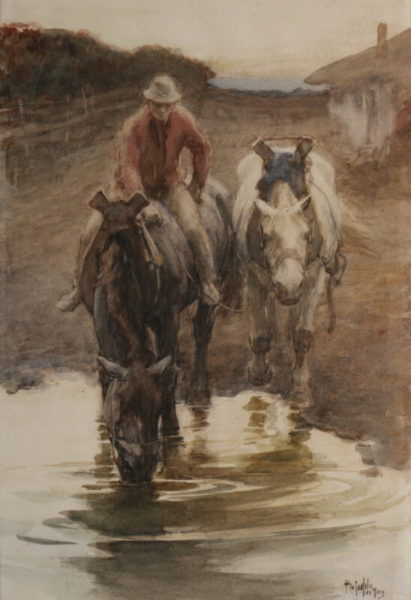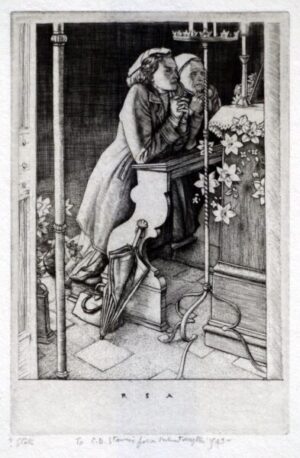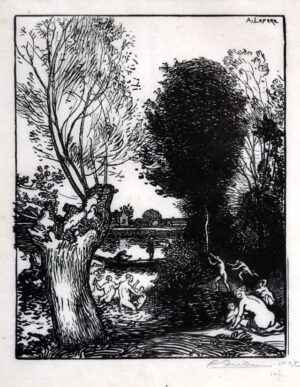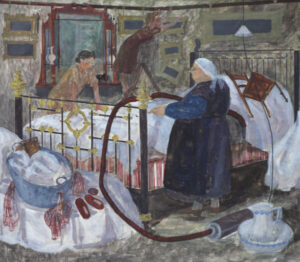Description
Pieter Josselin De Jong (1861-1906) was an internationally acclaimed artist who held a prominent position in the Hague art world.
De Jong was a versatile artist and technically gifted. He had a masterful eye for original subjects and was dedicated to the impartial, yet sympathetic portrayal of the lives of ordinary people in rural communities.
Rural Naturalism
The French painter Jules Bastien-Lepage was considered to be the leading painter of the Naturalist School in France. His work captivated a generation of painters internationally, at the time eclipsing the popularity of his impressionist counterparts. Naturalism so-called was primarily a French movement, and most of the works now seen as quintessential examples of the genre were produced by artists based in France.
In around 1860, a group of Dutch artists, inspired by their French peers, formed a collective based in Oosterbeek, in the rural south of the country. Like the Barbizon, Norwich, and Hudson River schools, this group focused on the landscape of their local region, and their activities drew a number of pilgrims to the area.
From the late 1860s onwards, this group gradually migrated to The Hague on the Dutch coast, many of them also visiting Fontainebleau to learn from the Barbizon painters and to make works of their own in response to the French countryside. Other key members of The Hague School – first defined in 1875 by the critic Jacob van Santen Kolff – include Johannes Bosboom, Johan Henrik Weissenbruch, Jozef Israëls, and Henrik Willem Mesdaz. The group became known for a more muted color-palette than that of the Barbizon painters, and for the influence which they drew from Dutch and Flemish Golden Age painters.
Brand
De Jong, Pieter Josselin (Dutch, 1861-1906)
Pieter de Josselin de Jong was born in Sint-Oedenrode, where his father was a notary. This encouraged Pieter to draw a lot. The family, which was part of the wealthy bourgeoisie, lived in Emmaus. Pieter attended primary school in Sint-Oedenrode and the HBS in Den Bosch.
In 1877, at the age of sixteen, he moved to Den Bosch, where his art education began.
That was at the Royal School of Useful and Visual Arts, an education that especially in the late 19th century and early 20th century produced an important group of artists. Besides Pieter de Josselin de Jong, Antoon Derkinderen, Herman Moerkerk, Jan Bogaerts, Antoon van Welie, Hendrik de Laat, Marius de Leeuw and Jan Sluijters also belonged there. Many of these artists were trained by two painters from the Bossche Slager family, Petrus Marinus Slager and his son Piet Slager.
After Den Bosch, De Josselin de Jong studied in Antwerp at the Academy of Fine Arts, and in Paris at the Ecole des Beaux Arts. He also made a study trip to Rome. His debut as a history painter was widely recognized and he led a busy life as a portrait painter. He worked in The Hague from 1883 to 1897. In 1897 he spent some time in Rheden, then in Wassenaar (until 1903). He lived and worked in The Hague from 1903 until his death in 1906.
He painted, watercolours, etched and drew portraits, figures and genre pieces. Later he also made landscapes and especially interiors of factories and workshops, especially in England, Limburg, and Drenthe. His interest in heavy industry yielded his most original contributions to Dutch painting. As a portrait painter, he painted a portrait of Queen Wilhelmina (now in Het Loo Palace) and of Queen Mother Emma (Centraal Museum Utrecht).
Pieter de Josselin de Jong received much appreciation in his time. King William III already awarded him a gold medal in 1883. But also later he received many awards (including Amsterdam 1883 and 1886; Paris 1889, 1900; St. Louis, USA, 1904).
The Noordbrabants Museum in Den Bosch has two portraits by his hand in the collection: one by Joseph Israëls (father of the painter Isaac) and one by Dora Jacobs-Hartogensis. His works hang in museums in Amsterdam, Delft, The Hague, Leeuwarden, Leiden, and Utrecht. The municipality of Sint-Oedenrode has the painting 'Two girls' by De Josselin de Jong in the collection. The famous painter is honored in the town hall with a bust.
He died in Amsterdam, where he was a member of the artists' society Arti et Amicitiae.



